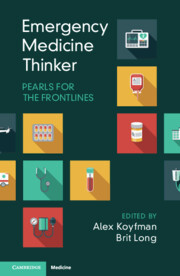Book contents
- Emergency Medicine Thinker
- Emergency Medicine Thinker
- Copyright page
- Contents
- Contributors
- Introduction
- Section 1 Decision-Making
- 1 On Deciding to Not Decide
- 2 What Makes Emergency Medicine Decision-Making Unique and Why?
- 3 Pediatric Emergency Medicine Approach: Be Vigilant but Be Reasonable
- 4 Decision-Making in Emergency Medicine
- 5 Emergency Medicine Medical Decision-Making
- 6 Decisions
- 7 Emergency Thinking and Behavior
- 8 Emergency Medicine Decision-Making
- 9 Emergency Medicine Decision-Making
- 10 Emergency Medicine Thinking and Cognitive Load Considerations
- 11 Decision-Making in Uncertainty
- 12 Unlearning and Thinking Differently
- 13 Decision-Making in Emergency Medicine
- 14 An Object in Motion
- 15 Too Little or Too Much?
- 16 Decision-Making in Emergency Medicine
- 17 Medical Decision-Making in the Emergency Department: Balancing the Patient’s Health with the Clinician’s Perception of Risk
- Section 2 Clinical Pearls
- Index
11 - Decision-Making in Uncertainty
The Hallmark of Emergency Medicine
from Section 1 - Decision-Making
Published online by Cambridge University Press: 14 March 2025
- Emergency Medicine Thinker
- Emergency Medicine Thinker
- Copyright page
- Contents
- Contributors
- Introduction
- Section 1 Decision-Making
- 1 On Deciding to Not Decide
- 2 What Makes Emergency Medicine Decision-Making Unique and Why?
- 3 Pediatric Emergency Medicine Approach: Be Vigilant but Be Reasonable
- 4 Decision-Making in Emergency Medicine
- 5 Emergency Medicine Medical Decision-Making
- 6 Decisions
- 7 Emergency Thinking and Behavior
- 8 Emergency Medicine Decision-Making
- 9 Emergency Medicine Decision-Making
- 10 Emergency Medicine Thinking and Cognitive Load Considerations
- 11 Decision-Making in Uncertainty
- 12 Unlearning and Thinking Differently
- 13 Decision-Making in Emergency Medicine
- 14 An Object in Motion
- 15 Too Little or Too Much?
- 16 Decision-Making in Emergency Medicine
- 17 Medical Decision-Making in the Emergency Department: Balancing the Patient’s Health with the Clinician’s Perception of Risk
- Section 2 Clinical Pearls
- Index
Summary
Emergency medicine (EM) is a prototypic example of a domain whereby decision-making is required without complete information. Although it is not unique, it certainly is a hallmark feature of the specialty. In fact, high-stakes decisions are frequently required under time-sensitive conditions with incomplete information. When a patient arrives in the ED with hemodynamic instability, initial decisions are made without a definitive diagnosis. The clinical team hedges toward management plans that effectively “buy” them time to improve hemodynamics while minimizing harm to the patient. Adding further challenges to the situation, there may be simultaneous and competing priorities elsewhere in the department. These high-stakes, time-sensitive conditions inherent in emergency medicine mandate a solid decision-making system. It is incumbent upon the clinician to develop pragmatic tactics and strategies that can be used in real time at the patient’s bedside. Clinicians are required to balance speed at the expense of certainty.
- Type
- Chapter
- Information
- Emergency Medicine ThinkerPearls for the Frontlines, pp. 78 - 85Publisher: Cambridge University PressPrint publication year: 2025

